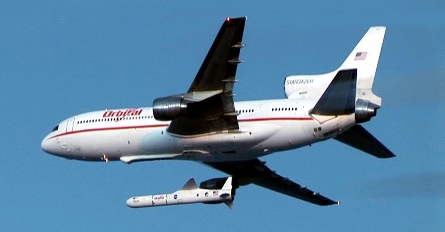Orbital Sciences' Pegasus launch vehicle has received final approval to launch NASA's nuclear spectroscopic telescope array (NuSTAR), scheduled for 13 June.
The launch entails dropping the rocket from Orbital Sciences' Lockheed L-1011 carrier aircraft, which will lift off from Kwajalein Atoll in the remote Pacific Ocean, carry the Pegasus to its designated launch area, and drop it from cruise altitude and speed. The launch window lasts approximately four hours, and no adverse weather is forecast.
The flight marks the first Pegasus launch since 2008, heralding the rocket's return to competitiveness. The solid-fuel rocket, which can loft up to 443kg (977lb) into low Earth orbit (LEO). Smallsats, which Pegasus is designed to launch, increasingly prefer to buy rideshares on larger rockets.
NuSTAR, a compact X-ray telescope that will expand a sizable antenna once in orbit, is designed to study black holes and other X-ray sources.
Orbital Sciences is also gearing up for the first flight of the larger Antares launch vehicle, which will carry supplies to the International Space Station under a NASA commercial contract. Though the Antares launch vehicle is reportedly ready for launch, construction of its new launch pad at Wallops Island, Virginia, remains unfinished.
 |
|---|
©Orbital Sciences |
Source: Flight International


























